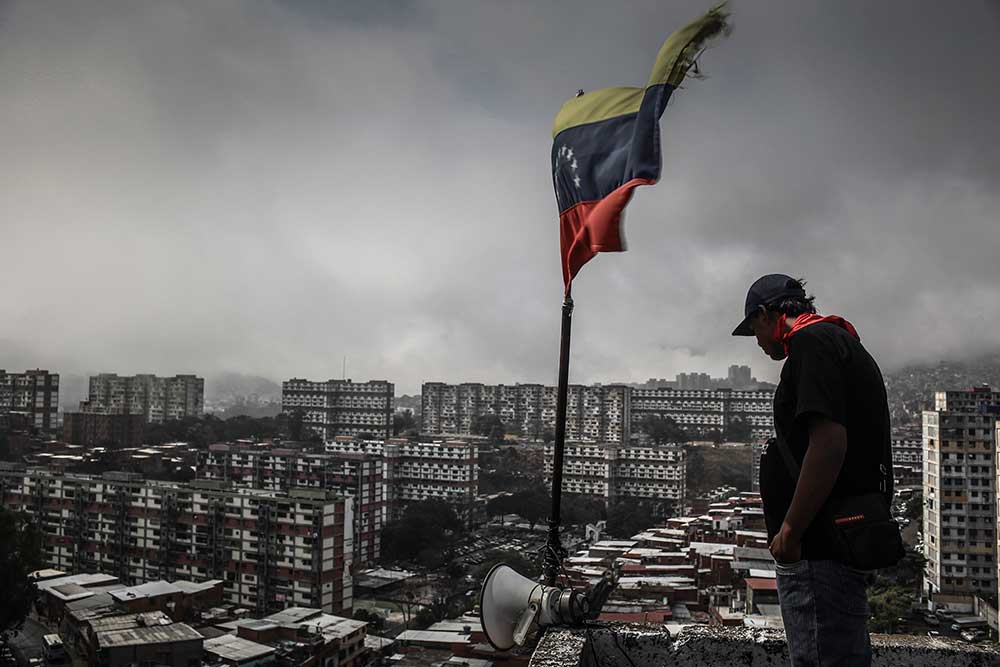INTERVIEW
Conflict and Intutition
WITH VALERY MELNIKOV
An interview with Valery Melnikov
Valery Melnikov won our ‘Urban Life’ theme with a dynamic image taken in Caracas, Venezuela – one that our judge, Steve MacLeod of Metro Imaging, thought reminiscent of the great Tony Ray Jones in its energy and creative framing. Valery has spent years working with news organisations inside Russia and has won recognition with organisations such as Magnum photo agency and World Press Photo for his work documenting conflict and upheaval around the world, and this particular image, as he explains below, marks a moment of playfulness and normality against the backdrop of such upheaval.
We invited the editors at Clique, the Sydney Morning Herald’s photography club, to ask some questions of Valery, and the resulting interview shared below first featured on their photographic blog. We invite you to check it out – www.cliquephotos.com.au

Valery, how do you approach street photography?
If the situation allows, I try to spend more time taking pictures. It gives the opportunity to come up with the plan, wait for the right moment and light to take the picture. Not only the plot and composition, but also the light has a very important meaning in photography. Many times, the intuition tells me to stay longer and for the right moment to take the picture.
What is it about street photography that interests you?
I really like to photograph street scenery, and make genre pictures. However, I do not consider myself a street photographer. I really prefer the genre of photo stories, long-term projects dedicated to a specific theme, problem, or event, where I can tell the complete story, with the help of series of pictures. For the last three years, I concentrated on the work related to the military conflict in Donbass, the south-eastern region of Ukraine. This tragedy of regular peaceful people is happening today, day after day, for the last three years
Tell us about your winning image. Where it was taken, how did it come about, what were you doing there, what’s going on in this photo?
I visited Caracas several days after the death of Venezuela President Hugo Chavez. It was a meaningful and emotional moment for all the citizens for this country, and especially for all poor people, because President Chavez was one of them, as well as his family. President Chavez was loved by his people, his entire country. A local journalist told me about Caracas’ region Barrio 23 de Enero. I decided to go there, because this barrio was under the special patronage of President Chavez, and all the people of this barrio supported their president.
The framing is really dynamic, the group of kids looking off camera at some object (a ball?) the expressions on their faces are brilliant, they are completely lost in the moment. Was this a single image that you took, or had you “camped” out at this spot to get the right image?
When I got there, I saw many children playing street basketball in front of a huge Che Guevara portrait. I was taking pictures of this scene for about 15-20 minutes from different angles. I knew that Che Guevara’s portrait was a very important part of this picture. It provided special surrealism to this situation. Thanks to this portrait, a simple game of street basketball got a completely different meaning.
OK, but did you realise there and then that you had a winning image?
I did not realise at the beginning, that the children would look the same way Che Guevara did. I made many different pictures during that game. Afterwards, while looking through all the pictures taken, I saw this photo, where no ball was present, and only kids, all looking into the sky. And of course, the Che portrait in the background was wonderful. I immediately knew this photo was not about basketball, as it has many different meanings: the revolution, the past that did not go away, young generation’s hope for the better future, and, quite possibly, disappointment. However, this understanding came after the picture was taken.






All images and text © Valery Melnikov.
See more of his work at www.valerymelnikov.com
